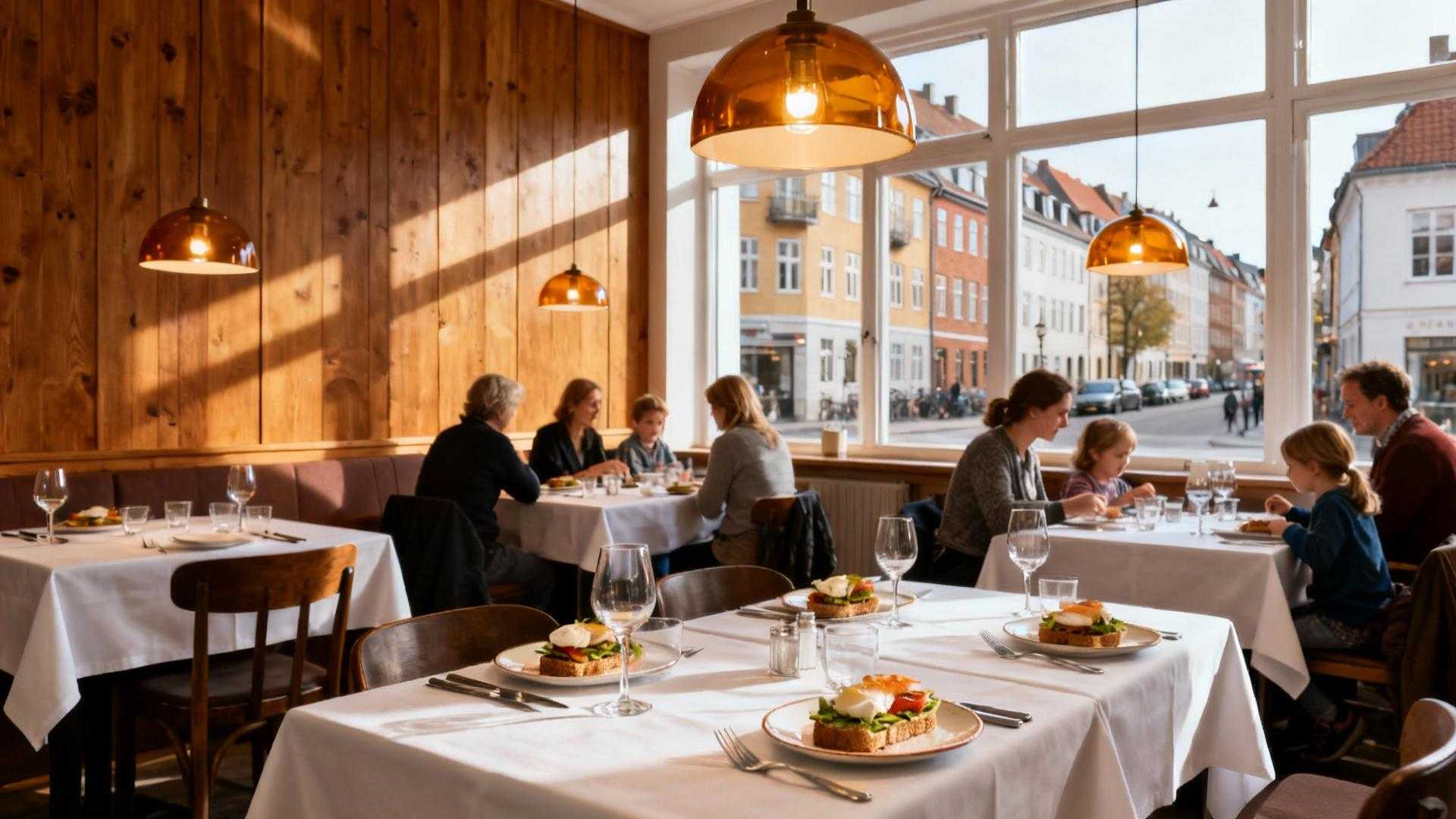I spent three years chasing Michelin stars across Copenhagen before a Danish colleague whispered something that changed everything: “If you want to understand what we actually eat, skip the $400 theater and meet me Sunday morning in Frederiksberg.” That conversation led me to Sokkelund Brasserie, a neighborhood institution where locals have quietly gathered since 1994—long before Instagram discovered their city. What I found wasn’t just exceptional food at $18 instead of $400. I discovered why Frederiksberg families guard this place like a secret, and why they’re right to worry about what happens when word gets out.
The moment you walk past Smallegade 36’s wood-paneled entrance, you understand the protection instinct. Three generations sit elbow-to-elbow over traditional smørrebrød, speaking Danish in hushed tones that respect the “subdued and discreet atmosphere” the brasserie has cultivated for over 30 years. This isn’t manufactured authenticity for tourists—it’s genuine Copenhagen dining culture that predates the city’s transformation into a foodie destination. While Noma pilgrims book reservations three months ahead and pay $400 for 20-course tasting menus, Sokkelund serves the same quality Danish ingredients in honest preparations that won’t require a second mortgage.
The anxiety locals feel isn’t snobbery—it’s preservation instinct born from watching other European treasures buckle under tourism pressure. When your Sunday morning ritual depends on availability, when your children grow up knowing exactly which corner table grandparents prefer, the thought of Instagram crowds feels like an existential threat.
Why Copenhagen locals actually protect this brasserie
The Sunday morning tradition tourists don’t understand
Søndagsmorgenbord—Sunday morning table—isn’t just brunch. It’s a sacred Danish institution where families claim the same tables week after week, ordering from separate weekend menus that honor traditions dating back generations. The brasserie opens at 9 AM Sundays, closing earlier at 10 PM (with kitchen service ending at 9 PM) because locals know: this day belongs to families, not late-night diners.
The pricing that makes daily dining actually sustainable
While exact menu prices fluctuate seasonally, Sokkelund operates in Copenhagen’s $$ range—meaning traditional open-faced sandwiches, aromatic moules frites, and “some of the juiciest burgers in town” cost what actual residents can afford multiple times monthly. Compare that to Noma’s $400 tasting menus or even mid-tier tourist traps charging $45 for lunch near Nyhavn. This isn’t budget dining—it’s honest pricing that respects neighborhood economics.
What makes this different from Copenhagen’s tourist restaurants
The adult-first atmosphere that filters casual crowds
Sokkelund states this explicitly: “Children are welcome, but they are here on the adults’ terms.” The brasserie maintains classic bistro interiors—white tablecloths, soft lighting, wood-paneled walls—that encourage lingering conversations over multiple courses. They refuse reservations exceeding eight people, protecting the intimate scale that makes Sunday mornings feel like family dining rooms rather than tourist dining halls.
The French-Danish soul that predates foodie trends
Founded in 1994 “long before Frederiksberg became one of Copenhagen’s trendiest dining destinations,” Sokkelund drew inspiration from Parisian brasseries with distinctly Danish soul. Their Star Wine List recognition and Travelers’ Choice award (ranking #8 among 271 Frederiksberg restaurants) validate what locals already knew: consistent quality matters more than Instagram moments. The menu spans oysters and lobster to traditional smørrebrød and salads, maintaining range without losing identity.
How to visit respectfully without ruining what makes it special
The booking strategy that shows cultural awareness
Sokkelund is “incredibly popular” requiring advance reservations—but timing reveals your understanding. Avoid Sunday mornings unless you’re prepared to witness (and respect) multi-generational family tradition. Weekday lunches (Monday-Thursday 8:30 AM-10:30 PM, kitchen closes 9:30 PM) offer the same menu with breathing room. Friday and Saturday extend to 11:30 PM, accommodating date nights without disrupting family rhythms.
The ordering approach that signals you understand Danish dining
Notice the separate brunch and morning menus for weekdays versus weekends—this isn’t random. Weekday breakfast caters to neighborhood professionals; weekend menus honor traditional Danish leisurely dining. Order traditional open-faced sandwiches with curiosity, not performative “authenticity hunting.” Ask about daily specials in English (widely spoken), but appreciate when locals converse in Danish around you—that’s the sound of preservation working.
Understanding what’s actually at stake here
When Frederiksberg residents worry about Sokkelund’s discovery, they’re protecting more than restaurant capacity. They’re safeguarding a 30-year-old neighborhood institution that survived because it served locals first, tourists incidentally. The moment economics flip—when tourist dollars outweigh resident loyalty—the character shifts. Menus translate fully to English. Service speeds up. Sunday tables become available because families can’t book ahead of organized tour groups.
If you visit Sokkelund, understand you’re entering a space locals actively work to preserve. Book ahead. Respect the adult-focused atmosphere. Don’t photograph other diners’ Sunday morning traditions. Order with genuine curiosity about Danish cuisine, not Instagram content hunger. And if you love it—which you will—consider whether sharing it publicly serves the place or just your feed. Some treasures deserve protection more than promotion.
Questions travelers ask about dining at Sokkelund
Do I need reservations for weekday lunch?
Sokkelund recommends booking in advance even for weekdays due to consistent local popularity. The intimate venue with small kitchen serves limited capacity, making walk-ins risky especially during peak lunch hours (12-2 PM). Weekend reservations are essential, particularly Sundays when family traditions fill tables.
What’s appropriate to wear to this brasserie?
The atmosphere is sophisticated yet down-to-earth—think smart casual rather than formal. Locals dress comfortably but respectfully for the wood-paneled, white-tablecloth setting. Avoid athletic wear or overly casual beach attire, but don’t feel pressure for cocktail dress either.
Can I experience traditional Danish food without speaking Danish?
Absolutely—English is widely spoken throughout Copenhagen, including at Sokkelund. However, the restaurant maintains Danish-language primacy in its atmosphere and some menu descriptions, which contributes to its authentic neighborhood character. Staff will gladly explain dishes and traditions to curious visitors who approach with genuine interest rather than demanding accommodation.
